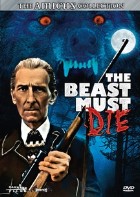
Amicus produced a handful of full-length features to counter-balance their more popular anthologies. While the quality of these, from the gothic/psychological terrors of Robert Bloch's The Skull to the science-fiction spectacles of Dr Who And The Daleks, are uneven, even the more bizarre, less successful entries are commendable in their willingness to attack non-traditional genre elements with unrepentant idiosyncrasy and fervor . Perhaps one of their most intriguing if uneven attempts at full-length horror was The Beast Must Die. The last gasp of Amicus, who had weathered the social changes that tore the bottom out from under Hammer, this crazy mix of deduction, William-Castle-like 'cheese,' and ancient lycanthropy is a modern monster movie and nod to the post-modern self-referencing of such later fear films as Scream.
In a hopelessly convoluted plot, Tom Newcliff (Calvin Lockhart), an arrogant, wealthy hunter who has pursued every animal imaginable (shadows of The Most Dangerous Game) save for -- yup, you guessed it, a werewolf -- invites some associates to an estate complete with James Bond-type gadgetry. Gathering a carefully selected group of authorities in anima behavior, folklore, and lycanthropy, Tom turns a vacation in his isolated country mansion into a nightmare. One of these folks is a werewolf, and a good part of the film focuses on him spying from a specially designed monitor room. Once he discovers the identity of the beast, he plans on killing it. Loosely adapted from a story by James Blish -- more often associated with science fiction than horror -- this mingling of morbidity and idiocy owes as much to the plot-tangling of Agatha Christie as to exploitation, succeeding more often as 'camp' than serious drama.
Proclaiming itself as "A detective story - in which YOU are the detective," this shlocky attempt at modernizing the folklore terrors of the werewolf is as humorous in its failings as it is enjoyable when the story and direction allow a more serious atmosphere of supernatural horror to resonate. The plot owes as much to the traditional 'who-done-it?' conventions of the British mystery thriller as to the supernatural. A single narrative whose emotional effectiveness to thrill and terrify is hampered by an unconscious tongue-in-cheek sentiment, The Beast Must Die still manages to fuse fun and fear. Whereas the Amicus anthologies poke fun at themselves, inviting audiences in on the joke, celebrating the conventions of genre by embracing both their ability to terrify and inspire laughter, this movie is often unconscious of its ridiculousness, achieving humor unemotionally, and thus is more camp than cult.
Chosen by Subotsky and Rosenberg to direct, Paul Annett's mad mixture of blacksploitation, adventure vehicle, and horror thriller never quite realizes what it is, but it sure has fun getting there! Unable to support its many plot-twists , the movie lacks direct focus. But you won't care because there are enough werewolf attacks, verbal-whippings, and hard-toned physical action to keep you riveted. Atmosphere and setting lend undeniable power to the proceedings. The expansive, lush yet foreboding grounds and beautifully shot interior designs are seeped in gothic mood, with shadows lurking in corners and subtle meaning playing over the exquisite faces of such thespian legends as Peter Cushing. Characters themselves are surprisingly believable (certainly more so than the plot as a whole), lent additional depth and tension by the aforementioned lighting, the later of which hovers like a spirit of destruction over all.
Among the invigorating characters are the tense pianist Jan Jarmokowski (Gambon), Paul Foote (Chadbon), a medical student once involved in an experiment of cannibalism, Arthur Bennington (Gray), a civil servant whose employees often disappear, and desirable Davinia Gilmore (Clark), a friend of Tom's wife. Of special note is Caroline Newcliffe (Clark), Tom's perpetually guilty-looking wife. Similar to a game of Clue, the viewer is presented with hints before the emergence of the much-debated "werewolf break," a goofy nod to the kind of William Castle showmanship where audiences are asked to select the identity of the werewolf. Friends, movies just aren't this fun anymore.
The picture quality here is no less pristine than Dark Sky's other recent Amicus releases, including the 16x9 Anamorphic Widescreen Transfer and an lively audio track. In a round of impressive extras (some culled from other releases, others created exclusively for this edition), a commentary featuring director Paul Annett (moderated by Jonathan Sothcott) allows us to explore his relationship with Amicus and his thoughts on Milton Subotsky and Max J. Rosenberg. In addition, he discusses fear-fave Peter Cushing, and his dislike of the "werewolf break' that, it appears, he didn't approve of. "Directing The Beast!", an interview with Annett follows, discussing a variety of trivia, including working with the dog (the film's werewolf), meeting Cushing, and other minor if entertaining info. We also get a still gallery and bios for Annett, Cushing, Gray, Diffring, Lockhart, Milton Subotsky & Max J. Rosenberg. Liner notes are followed by a touching Paul Annett tribute to Peter Cushing and trailers.
Review by William P Simmons
| Released by Dark Sky |
| Region 1 NTSC |
| Not Rated |
| Extras : see main review |